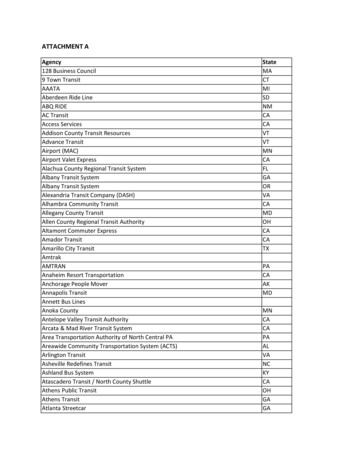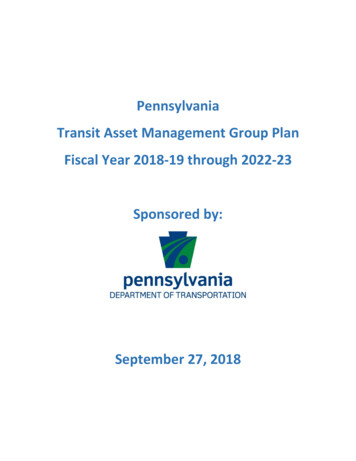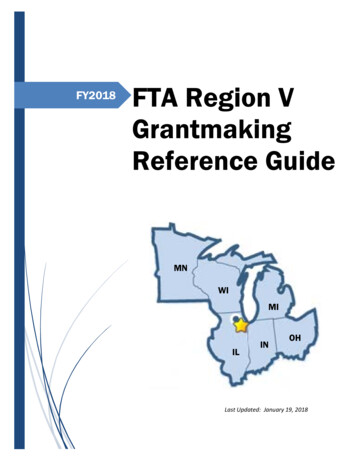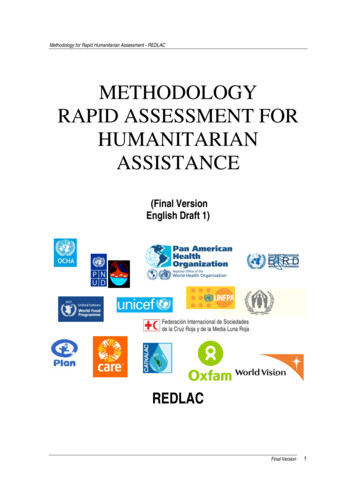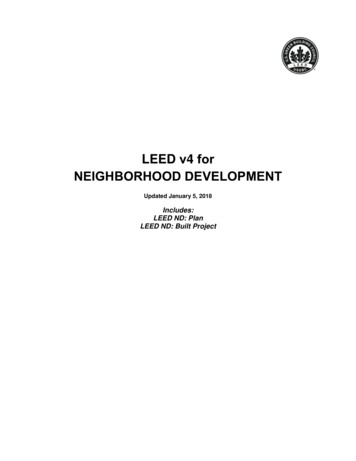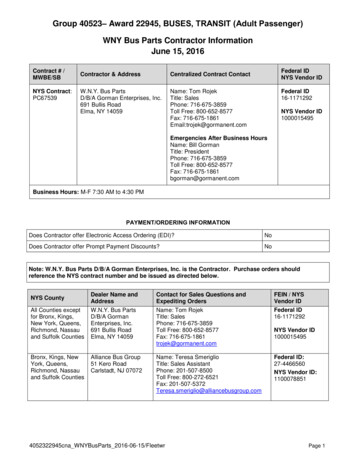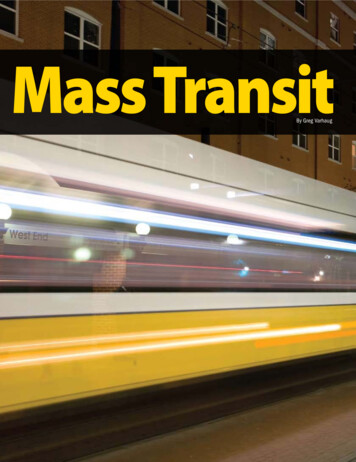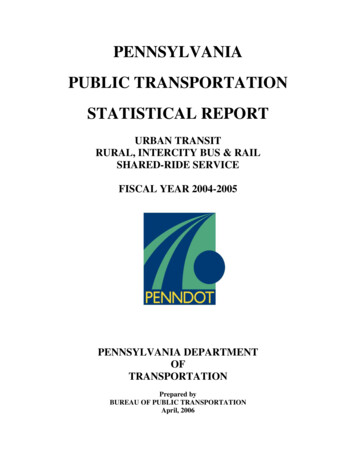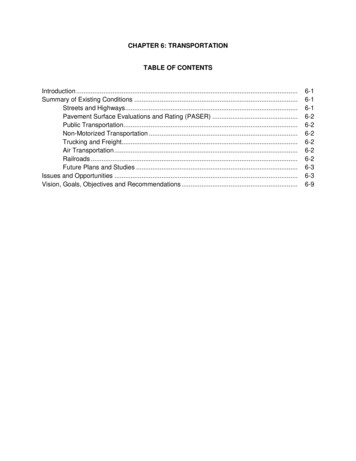
Transcription
TRANSITRAPID TRANSIT SYSTEM EXTENSIONSCOMPENDIUM OF DESIGN CRITERIAVOLUME VIISYSTEM EQUIPMENT DESIGN CRITERIACHAPTER 7COMMUNICATIONS DESIGN CRITERIAINTERIM RELEASEREV 1OCTOBER 30, 2008PROGRAM MANAGEMENT CONSULTANT
– Intentionally Left Blank –
TRANSIT– Intentionally Left Blank –VOLUME-VII – SYSTEM EQUIPMENTCHAPTER 7 – COMMUNICATIONSINTERIM RELEASE REV 1
TRANSITDOCUMENT REVISION RECORDISSUE NO.DATE05-10-07Interim Release110-30-08Revisions to incorporate MIC-EHdesign specifications that havebeen adopted by MDT.ISSUE NO.1REVISION DESCRIPTIONSSECTIONS CHANGED7.04.2.L Voice, Data and Video Operational Criteria Communications System Configuration CriteriaPage 10 – “Intentionally Left Blank” text added.Page 42 – “Intentionally Left Blank” text added.Page 44 – “Intentionally Left Blank” text added.VOLUME-VII – SYSTEM EQUIPMENTCHAPTER 7 – COMMUNICATIONSINTERIM RELEASE REV 1
TRANSIT– Intentionally Left Blank –VOLUME-VII – SYSTEM EQUIPMENTCHAPTER 7 – COMMUNICATIONSINTERIM RELEASE REV 1
TRANSITVOLUME VII – SYSTEM EQUIPMENT CRITERIACHAPTER 7 COMMUNICATIONSREVISION 1Table of ContentsPage7.01 INTRODUCTION . 17.01.1 SCOPE. 17.02 BACKGROUND - CABLE TRANSMISSION SUBSYSTEM (CTS) AND DATATRANSMISSION SYSTEM (DTS). 37.03 GENERAL . 47.04 VOICE, DATA and VIDEO OPERATIONAL CRITERIA . 107.04.1 OPERATIONAL CRITERIA . 117.04.2 COMMUNICATIONS SYSTEM CONFIGURATION CRITERIA. 137.04.3 INTERFACE STANDARDS . 157.05 COMMUNICATIONS SUBSYSTEMS FEATURES . 197.05.1 RADIO SUBSYSTEM . 197.05.2 PRIVATE AUTOMATIC BRANCH EXCHANGE (PABX) SUBSYSTEM . 207.05.3 TELEPHONE SUBSYSTEM. 227.05.4 PASSENGER ASSISTANCE TELEPHONE. 237.05.5 INTERCOMS. 237.05.6 OTHER TELEPHONES. 247.05.7 PUBLIC ADDRESS AND AUDIO-VISUAL SUBSYSTEM . 257.05.8 VARIABLE MESSAGE SIGNS . 267.05.9 CLOSED CIRCUIT TELEVISION SUBSYSTEMS (CCTV). 277.05.10 FIRE ALARM COMMUNICATIONS . 297.05.11 ACCESS CONTROL SYSTEM with INTRUSION ALARMS. 307.05.12 ATTENDANT’S BOOTH OR CONSOLE . 317.05.13 SUPERVISOR’S BOOTH . 327.05.14 DATA BETWEEN THE STATIONS AND THE CCF . 337.05.14.1At the Stations – The SCADA system . 337.05.14.2At the Stations – The Data system. 347.05.14.3CCF Requirements – . 357.05.15 UNINTERRUPTABLE POWER SUPPLY . 357.06 COMMUNICATION CRITERIA FOR PARKING STRUCTURES . 377.06.1 VEHICLE COUNTING AND DISPLAY SYSTEM. 377.06.2 PARKING STRUCTURE CCTV SYSTEM. 377.06.3 PARKING STRUCTURE FIRE ALARM PANELS. 397.06.4 PARKING STRUCTURE UPS SYSTEM . 407.06.5 PARKING STRUCTURE NETWORK CONNECTIVITY . 407.07 REMOTE AND LOCAL MANAGEMENT OF SUBSYSTEMS. 427.07.1 PERFORMANCE CRITERIA AND INTERFACE STANDARDS . 437.07.2 COMMUNICATIONS SYSTEM SECURITY . 43VOLUME-VII – SYSTEM EQUIPMENTCHAPTER 7 – COMMUNICATIONSiINTERIM RELEASE REV 1
TRANSIT7.08 MISCELLANEOUS . 447.08.1 RACEWAYS AND CONDUITS. 457.08.2 CABLES . 467.08.3 STANDARDIZATION AMONG STATIONS . 477.09 THE MDT COMMUNICATIONS NETWORK (MCN) . 497.09.1 GENERAL . 497.09.1.1 Core Layer;. 497.09.1.2 Access Layer; . 497.09.2 FIBER OPTIC BACKBONE CABLE . 497.09.3 NETWORK EQUIPMENT. 517.09.4 NETWORK INTERFACES . 527.09.5 RESERVED. 547.09. 6 INSTALLATION TC&C ROOM . 547.09. 7 MAINTENANCE CONSIDERATIONS . 547.09. 8 OTHER. 55APPENDIX A – . 57Table 1 -EXAMPLE DISCRETE DATA POINT SCHEDULE* . 57VOLUME-VII – SYSTEM EQUIPMENTCHAPTER 7 – COMMUNICATIONSiiINTERIM RELEASE REV 1
TRANSIT7.01INTRODUCTION7.01.1SCOPEThis Chapter identifies the criteria which will apply to the design andimplementation of the MDT communications system.Other MDT design criteria impact the communications system and should bereferenced during the design process. They include, but are not limited to;oVolume I, chapter 7,System SafetyoVolume I, chapter 8, System SecurityoVolume I, chapter 9, Fire Life SafetyoVolume II, chapter 4, Station ElectricaloVolume III, chapter 4, Guideway ElectricaloVolume VII, chapters 1,2, & 3, Traction Power EquipmentoVolume VII, chapter 6, Train ControloVolume VII, chapter 4, Fare Collection SystemIn general, the following comprise the basis of the MDT communicationssystem:A systemwide backbone communications network consisting of;oFiber optic cables routed from the Central Control Facility (CCF) toeach station or other wayside facilityoLayer 3 Network Switches with Ethernet interfacesIn this document, this backbone communications network is referred to as the“Metrorail Communications Network” or “MCN” and provides thecommunications interfaces to all MDT sub-systems.VOLUME-VII – SYSTEM EQUIPMENTCHAPTER 7 – COMMUNICATIONS1INTERIM RELEASE REV 1
TRANSITSTATION communications subsystems, consisting of;A.Voice - to include telephones, intercoms and the Public Address (PA)system.B.Data –1.Discrete PLC inputs, the commands and indications, and2.Equipment with Ethernet interfaces for IP data exchange with theCentral Control Facility.C.Video – The Closed Circuit Television (CCTV) SubsystemStation in this document includes the passenger stations, traction powersubstations and wayside facilities.Central Control Facilities (CCF) communications subsystems, consisting of;A.Voice – PABX, Digital Cross Connect, PA equipment and telephonesB.Data - PLCs with I/O interfaces and related computer equipment, andequipment with Ethernet interfaces for IP data exchange with stationsC.Video – Monitors, recorders and switchersThe design will include all supporting hardware, software, interfaces,conduits, cabinets, cables and connectors to form a complete system tosupport the communications needs of the MDT subsystems.VOLUME-VII – SYSTEM EQUIPMENTCHAPTER 7 – COMMUNICATIONS2INTERIM RELEASE REV 1
TRANSIT7.02BACKGROUND - CABLE TRANSMISSION SUBSYSTEM (CTS)AND DATA TRANSMISSION SYSTEM (DTS)The original MDT Phase I Cable Transmission System (CTS) was a T1system implemented in a “star” configuration. Two copper T1 cables wererouted, one in each guideway cabletray, from the CCF to each station toprovide 100% CTS redundancy. Channel banks were connected to the T1system to provide voice (telephone, PA & intercom) and data interfaces.Telephones, PA, and Data from the Data Transmission System (DTS)connections were routed through an A-B switch. If a failure was detected onthe primary T1 channel, the A-B switch automatically switched the interfacesto the backup T1 channel, thereby providing continuous operation and highsystem availability.In 1997, this T1 cable system was replaced with a fiber optic cable system ina ring configuration with an OC-3 SONET multiplexer at each stationproviding similar T1 services. Channel banks and A-B switches wereupgraded. A Programmable Logic Controller (PLC) system replaced the DTSsystem. This PLC system is also referred to as the SCADA (SupervisoryControl and Data Acquisition) system.Later, an Ethernet switch was installed at each station and at the CCF toprovide Ethernet connectivity for data transmission of select systems. Voice(telephones, PA & intercom) and some data transmission remain on thechannel bank/SONET system.“CTS” and “DTS” terminology still appears within MDT drawings anddocuments. Within these new design criteria, the older CTS and DTSterminology is replaced with “Metrorail Communications Network” or “MCN”.VOLUME-VII – SYSTEM EQUIPMENTCHAPTER 7 – COMMUNICATIONS3INTERIM RELEASE REV 1
TRANSIT– Intentionally Left Blank –VOLUME-VII – SYSTEM EQUIPMENTCHAPTER 7 – COMMUNICATIONS4INTERIM RELEASE REV 1
TRANSIT7.03GENERALA.The information within this criteria when used in conjunction with theapplicable specifications, drawings and documentation of the existingMDT communications configuration, codes and other applicable systemdesign criteria (from other MDT subsystems requiring communications),will assist the designer in creating the technical contractual documents.Equipment quantities are to be provided by the designer. The criteriapresented herein are minimum requirements not intended to supplantthe exercise of engineering judgment by the Engineer of Record.B.The Designer must perform the design to a specification level – furnishand install with instructive diagrams, processes and procedures toinclude single line diagrams of signals, description of the types of signal;e.g. discrete command or indication, Ethernet or serial type ofcommunications, video signals and voltage levels for power, etc.C.Requirement of specific projects which may conflict with these designcriteria must be brought to the attention of MDT in a timely manner forresolution.D.All new designs must be consistent in design and compatible inoperation with the existing MDT communications system and MDT subsystems. Exceptions to these design criteria must be submitted to MDTfor approval.E.Communications subsystems are to be designed to include allsupporting hardware, software, interfaces, cabinets, conduits, cablesand connectors to form a complete communications network in supportof all MDT subsystems requiring communications.VOLUME-VII – SYSTEM EQUIPMENTCHAPTER 7 – COMMUNICATIONS5INTERIM RELEASE REV 1
TRANSITF.The designer should consider impact to MDT revenue service duringconstruction and cutover. Such work must be identified by the designerand minimized.G.Test and Acceptance Plan - An extensive test procedure is required withdetailed test results to be recorded. These initial test results will becomethe system’s baseline performance to be used as a reference for futuremaintenance.H.The current adopted version of these codes, standards and regulationsshall apply, and unless otherwise directed, all addenda, interimsupplements, revisions and ordinances by the respective code bodyshall also apply. Where conflicts exist between these requirements, themore stringent requirement shall take precedence, unless otherwisedirected by MDT.oNational Electrical Code (NEC)oNational Electrical Safety Code (NESC)oLocal Codes and Authorities Having JurisdictionoAmerican National Standards Institute (ANSI)oNational Electrical Manufacturers Association (NEMA)oInstitute of Electrical & Electronic Engineers (IEEE)oInsulated Cable Engineers Association (ICEA)oAssociation of American Railroads (AAR)oRural Electrification Administration, Telephone Engineering andConstructionoJoint Electron Device Engineering CounciloElectronic Industries Association (EIA)VOLUME-VII – SYSTEM EQUIPMENTCHAPTER 7 – COMMUNICATIONS6INTERIM RELEASE REV 1
TRANSIToNEBSoTELECORDIAoUnderwriters’ Laboratories, Inc. (UL)oElectronic Industries Alliance (EIA)oFederal Communications Commission (FCC)oFederal Railroad Administration (FRA)oIlluminating Engineering Society (IES)oOccupational Safety and Health Administration (OSHA)oInternational Standards Organization (ISO)oDepartment of Environmental Resource Management (DERM)oAmerican with Disabilities Act (ADA)oConstruction Specifications Institute (CSI)In addition, the following specific standards shall apply;ANSI/IEEE 81 Guide for Measuring Earth Resistivity, Ground Impedance,And Earth Surface Potentials of a Of A Ground System (Part 1)ANSI/TIA/EIA-568-A Commercial Building Telecommunications CablingStandardANSI/TIA/EIA-569-A Commercial Building Standard for TelecommunicationsPathways and SpacesANSI/TIA/EIA-607 Commercial Building Grounding and BondingRequirements for TelecommunicationsIEEE C62.41 IEEE Recommended Practice on Surge Voltages in LowVoltage AC Power Circuits.VOLUME-VII – SYSTEM EQUIPMENTCHAPTER 7 – COMMUNICATIONS7INTERIM RELEASE REV 1
TRANSITIEEE C62.45 IEEE C62.45 IEEE Guide on Surge Testing for EquipmentConnected to Low-Voltage AC Power Circuits.IEEE Green Book; IEEE STANDARD 142 Recommended Practice forGrounding of Industrial and Commercial Power SystemsIEEE Orange Book; IEEE STANDARD 446 IEEE Recommended Practicefor Emergency and Standby Power Systems for Industrial and CommercialApplicationsMIL-HDBK-419A Communications Facilities Design and ConstructionNFPA 70 National Electrical Code Articles 250, 280, 285 and 800NFPA 780 Standard for the Installation of Lightning Protection SystemsMotorola document 68P81150E62 Grounding Guideline for Cellular RadioInstallationsUL 467 Grounding and Bonding EquipmentUL 497A Secondary Protectors for Communication CircuitsUL 497B Protectors for Data Communication and Fire Alarm CircuitsUL 1449 Transient Voltage Surge SuppressorsNFPA 72 National Fire Alarm CodeVOLUME-VII – SYSTEM EQUIPMENTCHAPTER 7 – COMMUNICATIONS8INTERIM RELEASE REV 1
TRANSITNFPA 130 Fixed Guideway Transit and Passenger Rail SystemsNFPA 76 Fire Protection of Telecommunications FacilitiesNFPA 101 Life Safety CodeNFPA 110 Emergency and Standby Power SystemsVOLUME-VII – SYSTEM EQUIPMENTCHAPTER 7 – COMMUNICATIONS9INTERIM RELEASE REV 1
TRANSIT– Intentionally Left Blank –VOLUME-VII – SYSTEM EQUIPMENTCHAPTER 7 – COMMUNICATIONS10INTERIM RELEASE REV 1
TRANSIT7.04VOICE, DATA and VIDEO OPERATIONAL CRITERIA7.04.1OPERATIONAL CRITERIAMDT requires that no subsystem is dependant upon the Communicationssystem for safe operation. Specifically;A.The Communications System shall be designed such that any failure ormalfunction cannot cause an unsafe condition or adversely affectoperation of the train control or traction power subsystems.B.Communications Interfaces shall be designed to allow local operation ofthe subsystems at the station by onsite MDT personnel. That is, traincontrol, traction power and other functions can be controlled locally atthe stations in a safe manner without the Communications Systemoperating.C.The Fire alarm system, access control system, and local Public Address(PA) System announcements at the station are also not to be dependentupon communications to or from central control for safe local operationeither autonomously or by a station attendant or MDT personnel. Anycommunications requirements for emergency systems and codecompliance shall be addressed and given special consideration whereneeded.D.Brown outs, power up, power down and interruptions are to be handledin a safe and orderly manner.E.Availability – The availability of the communications system’s corenetwork layer (the backbone) for each station to CCF communicationslink shall be 99.999%.VOLUME-VII – SYSTEM EQUIPMENTCHAPTER 7 – COMMUNICATIONS11INTERIM RELEASE REV 1
TRANSITThe availability of the network access layer for all station Ethernetinterfaces to CCF Ethernet interfaces shall be 99.99%.F.Maintainability – the target MTTR (Mean time to Repair) shall be lessthan 30 minutes after a MDT technician arrives on site. This targetMTTR should be considered by the designer when specifying spares,training, documentation, diagnostic programs, etc. Dependant upondesign specifics, the target MTTR can be adjusted accordingly.G.Reliability – No single point of failure shall interrupt communications.This includes access layer communications to MDT subsystems, e.g.,communications interfaces and cabling from the Ethernet patch panel toeach fare collection machine shall be separate and independent of anyother machine.H.No local Ethernet hubs are permitted outside of the TC&C room withoutapproval of MDT. All connections to Ethernet interfaces on thesubsystems are to be home run back to the Ethernet patch panel in theTC&C room with their own independent, labeled cable.I.Communications from each station shall be independent of otherstations, with the exception of Hubs at key locations.Commentary: MDT preference is to migrate from the SONET ringconfiguration to a star configuration of Ethernet switches, with each stationhaving its own separate fiber path to the CCF. Hubs at key locations areacceptable upon approval by MDT.)VOLUME-VII – SYSTEM EQUIPMENTCHAPTER 7 – COMMUNICATIONS12INTERIM RELEASE REV 1
TRANSITJ.Provide Multiple Control Center Facility Capability – Capability ofhanding off control from CCF to another location within the MDTcommunications network.K.Provide the capability and access at multiple locations within the MDTCommunications Network to monitor the system’s data and video andwith proper password protection to control the subsystems.L.Provide Multicast video capability – A video feed to others, e.g. lawenforcement.7.04.2COMMUNICATIONS SYSTEM CONFIGURATION CRITERIAThe communications system configuration criteria will be designed toincorporate, as a minimum, the following requirements, unless otherwiseapproved by MDT:A.Modular construction will be utilized wherever possible with commonalityof modules provided to the highest degree attainable.B.Off the shelf equipment which follows industry standards shall beutilized. All equipment to be installed shall be new, listed in themanufacturer’s most current catalog, and in current production.C.The system must be Scalable – Bandwidth and interfaces can beincreased with only incremental cost of the new equipment. EquipmentChassis shall be sized for expansion of 25 % to include powerrequirements, cooling, etc. Empty slots shall have blank covers.VOLUME-VII – SYSTEM EQUIPMENTCHAPTER 7 – COMMUNICATIONS13INTERIM RELEASE REV 1
TRANSITD.A Train Control & Communications (TC&C) electrical panel (PP1)supplying power to all communications equipment shall be directlypowered by the station’s Uninterruptible Power Supply (UPS) to ensureno-break in power application during primary power source interruption.The UPS shall contain its own internal Automatic Transfer Switch (ATS)E.Individual communications subsystem protection will be included throughproper fusing or circuit breakers at the TC&C electrical distribution panel– PP2.F.Primary and backup power loss at any station or stations shall not affectcommunications between the CCF and any other station. If needed, thebackbone communications equipment shall also be powered by its own4 hour battery supply in addition to the TC&C room’s backup powersource to avoid such an interruption.G.Non Volatile memory (or an equivalent method) is required forconfiguration and application software and operating data, such that apower failure and restoration will not adversely affect MDT operations.H.Estimated heat load of equipment in TC&C room is to be calculated andprovided to the Architect to assist in proper sizing of the HVAC unit.I.General purpose receptacles are to be provided on the cabinets formaintenance personnel use – a separate circuit, GFI protected.J.Metal Cabinets with locks (keys to be common to existing MDT keys)VOLUME-VII – SYSTEM EQUIPMENTCHAPTER 7 – COMMUNICATIONS14INTERIM RELEASE REV 1
TRANSITK.Cable Management and structured cable practices per EIA/TIA- 568/569specification are to be followed.L.Environmental spec – Backbone equipment to be carrier classequipment; temp range of 0 C to 40 C or better with non-condensinghumidity of 95%. Backup A/C units shall be provided in the equipmentroom. If needed, cooling fans are to be provided within the cabinets.M.Over temperature indicator within TC&C room (A/C fail) to report to CCFis required. Equipment Communications to CCF are to be alarms fromthe Stations to the CCF through the SCADA system, or via theequipment’s an equipment “smart” Ethernet interface- if so provided.7.04.3N.Outdoor equipment to be a minimum NEMA 4X rated.O.All conduits in public areas are to be concealed.P.Pullboxes are to be readily accessible or accessible as defined by NEC.INTERFACE STANDARDSA.The communications system shall transmit and receive EIA standardsignal levels at interface points.Commentary: MDT has adopted TCP/IP over Ethernet as theircommunications standard. To the maximum extent possible, MDT desiresConvergence, that is, all types of communications signal are to betransmitted as IP data packets over the communications network, toinclude;1. Voice over IP – VoIPVOLUME-VII – SYSTEM EQUIPMENTCHAPTER 7 – COMMUNICATIONS15INTERIM RELEASE REV 1
TRANSIT2. Ethernet interfaces on subsystem equipment .3. Video as MPEG2, or MPEG4 data (See Section 7.05.9MDT presently uses a proprietary Vicon standard (for security reasons)and MPEG2 encoding for video data. Designer shall coordinate withMDT to assure compatibility of new designs with the existing system.B.All MDT subsystems connected to the MDT communications systemshall be IP addressable.C.The standard interface at the access layer will be the Ethernet interfaceon the layer 3 switch. For equipment not providing an Ethernetinterface, serial RS-232 and RS-422 interfaces are acceptable as analternative. Equipment using serial interfaces shall be routed into a portserver. The port server is then connected to the MDT access layerEthernet interface thereby providing IP addressability to the equipment.Distance limitations are to be observed, typically;1.Ethernet over copper (100BaseTX) has a 100 meter limitation.2.RS-422 over shielded twisted copper pairs has a 4000 footlimitation.3.Ethernet over Multi Mode fiber optic cable has a limitation of 2 Kmat 5 Mhz.D.For discrete PLC inputs and outputs, wire size for commands andindications to the PLC modules shall not be less than AWG #20. Forthis wire size, a distance limitation of 100 feet shall apply to PLC inputsfrom MDT systems. For longer distances, the wire size may need to beVOLUME-VII – SYSTEM EQUIPMENTCHAPTER 7 – COMMUNICATIONS16INTERIM RELEASE REV 1
TRANSITincreased. The voltage drop must be calculated to stay within theacceptable operating range of the PLC modules and the MDT system.E.For discrete PLC inputs and outputs originating in a building other thanthe TC&C room, a remote PLC I/O module is acceptable. The remotePLC I/O module will then transmit the data to the station’s PLC in theTC&C room.F.For all wiring entering the TC&C room proper surge protection isrequired on both ends of the conductors. This includes communicationssignal and power wiring.G.Clear demarcation points between the Communications interfaces andMDT subsystem interface are required, as follows;1.For Discrete commands and indications, Wiedmuller typetermination blocks with knife switches are required. On the PLCmodules, LED type Indicators are to show the status of each inputor output.Commentary: See existing MDT configuration at a station2.For telephones and intercoms, a board with 66 or 110 type punchdown blocks with protectors at the de-marcation point.a.For data cables, Patch panels are required for inputs to theEthernet switch interface.b.For the Fiber Optic backbone cable, Patch panels with cabletermination and distribution is required.H.Automatic A-B switching of interfaces, dual communications interfaces,or an equivalent method is required to provide communicationredundancy to MDT subsystems. Single points of failure are to beVOLUME-VII – SYSTEM EQUIPMENTCHAPTER 7 – COMMUNICATIONS17INTERIM RELEASE REV 1
TRANSITavoided. MDT shall be made aware of any potential single points offailure exist within the design.I.Access to maintenance alarms, indicators and test points are to beprovided for testing of all major and critical circuits and assemblies.Front panel LEDs on the equipment to indicate a normal/fail conditionare desirable.VOLUME-VII – SYSTEM EQUIPMENTCHAPTER 7 – COMMUNICATIONS18INTERIM RELEASE REV 1
TRANSIT7.05COMMUNICATIONS SUBSYSTEMS FEATURESMajor features of individual communications subsystems are enumeratedbelow with descriptions of how each subsystem is to accomplish its primaryfunction.In general, the MDT communications subsystems are defined as:A.B.Voice – The voice system will transmit:1.Two-way voice - Radio, telephone, and intercom communications2.One-way voice - Station public address communicationsData – Consisting of:1.Discrete commands and indications between the station and theCCF using the PLC I/O interfaces (SCADA) and,2.C.Data packet exchanges, typically IP data packets over Ethernet.Video – CCTV for system security.1.The video system will transmit color video signals from the stationsto Central Control. At locations where PTZ cameras are required,the communications system will provide two way datacommunications to support CCTV camera Pan, Tilt, Zoom (PTZ)and management.7.05.1RADIO SUBSYSTEMA.The Radio subsystem will utilize an individual base station for eachchannel with remote control capability from Central Control and multichannel portable mobile and personal transceivers capable ofcommunicating on any of the available channels assigned to the transitsystem. All equipment will be of modern solid state design. Base stationVOLUME-VII – SYSTEM EQUIPMENTCHAPTER 7 – COMMUNICATIONS19INTERIM RELEASE REV 1
TRANSITtransmitters and receivers will be single channel equipment. Mobile,portable and personal radio transceivers will have multi-channeloperational capability with automatic transmitter identification. Receivervoting equipment will be used to select the active receiver with thehighest signal to noise ratio in order to obtain greatest systemoperational reliability.B.Radio communications within structures such as the station’s TC&Crooms shall be assured of quality reception between the station and theCCF. Conduits for “leaky coax” or an equivalent alternative system toimprove reception shall be installed where conditions may cause radiodropouts. Contractor shall perform a radio test and install the leaky“coax” or an equivalent system, as needed, to provide reliable two waycommunication from the location to the CCF.C.RADIO system expansion requirements - No new design requirement atthis time.Commentary: MDT may require procurement of additional radioswithin the extension contract.D.Automatic Vehicle Location (AVL) requirements – No new designrequirement at this time - Designer to confirm with MDT.7.05.2PRIVATE AUTOMATIC BRANCH EXCHANGE (PABX) SUBSYSTEMCommentary: The MDT PABX is a Nortel Meridian Option 61. All linesare presently in use, but expansion capability exists. A Tellabs DigitalCross Connect (DCS) is presently installed to groom the voice and datalines from the stations into separate DS 1 lines at central to be routed toVOLUME-VII – SYSTEM EQUIPMENTCHAPTER 7 – COMMUNICATIONS20INTERIM RELEASE REV 1
TRANSITeither the PABX for voice , or to channel banks populated with datacircuit cards for SCADA data exchange with MDT subsystems at the CCF.For the PA system, E&M type circuit cards are used at each station and atCCF to detect when the PA at the station is not busy with another higherpriority announcement, and to” key” the station PA for an announcementfrom central.)A.The existing PABX subsystem with its related equipment to include theDigital Cross Connect (DCS) will require expansion to accommodate thenew telephone sets, intercoms, and PA equipment needed for eachMetrorail expansion project. The new equipment must meet the specificoperational characteristics required of each new telephone, intercom orPA line and also interface to the existing equipment where required.B.Coordinate assignment of Extension numbers for new telephones withMDT.C.All telephone voice lines will be routed to the CCF PABX. If the VoIPimplementation requires other
Oct 30, 2008 · IEEE C62.45 IEEE C62.45 IEEE Guide on Surge Testing for Equipment Connected to Low-Voltage AC Power Circuits. IEEE Green Book; IEEE STANDARD 142 Recommended Practice for Grounding of Industrial and Commercial Power Systems IEEE Orange Book; IEEE STANDAR
